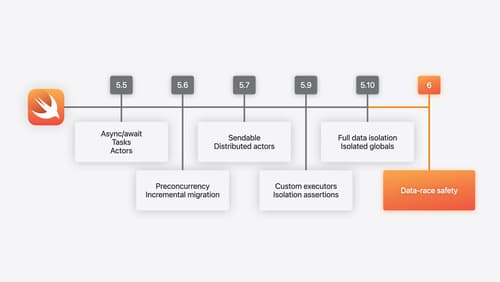Concurrency
Asked on 2024-07-31
33 searches
Concurrency in Swift has been significantly enhanced with the introduction of Swift 6, focusing on data race safety and improved concurrency management. Here are some key points discussed in various sessions at WWDC:
-
Data Race Safety:
- Swift 6 achieves data race safety by default, turning potential data race issues into compile-time errors. This helps in massively improving the security of your app and reducing debugging time (What’s new in Swift).
- Data races can occur when multiple threads share data and one of them tries to mutate it. Swift 6's concurrency model ensures that such issues are caught at compile time (A Swift Tour: Explore Swift’s features and design).
-
Actors:
- Actors are a new feature in Swift that help manage concurrency by serializing access to their mutable state. This ensures that only one task can execute at a time on an actor, preventing data races (A Swift Tour: Explore Swift’s features and design).
- Actors are similar to classes but provide automatic protection for their state, making them a convenient way to handle shared mutable state in concurrent programming (A Swift Tour: Explore Swift’s features and design).
-
Concurrency Management:
- Swift 6 introduces a more structured approach to concurrency, moving away from ad-hoc concurrency architectures to a more organized model using actors and the main actor for UI-related tasks (Migrate your app to Swift 6).
- The Swift concurrency model makes guarantees about how callbacks are called, ensuring that data requiring certain isolation is accessed correctly (Migrate your app to Swift 6).
-
Migration to Swift 6:
- Migrating to Swift 6 involves enabling strict concurrency checking, which helps identify and fix concurrency issues in your code. This can be done incrementally, module by module (Migrate your app to Swift 6).
- The migration process includes updating delegate callbacks and ensuring that they conform to the new concurrency model (Migrate your app to Swift 6).
-
Low-Level Synchronization Primitives:
- Swift 6 introduces new low-level synchronization primitives, such as atomics, which provide efficient, lock-free implementations for synchronization (What’s new in Swift).
Relevant Sessions
These sessions provide a comprehensive overview of the new concurrency features in Swift 6 and how to migrate your existing code to take advantage of these improvements.

A Swift Tour: Explore Swift’s features and design
Learn the essential features and design philosophy of the Swift programming language. We’ll explore how to model data, handle errors, use protocols, write concurrent code, and more while building up a Swift package that has a library, an HTTP server, and a command line client. Whether you’re just beginning your Swift journey or have been with us from the start, this talk will help you get the most out of the language.

What’s new in Swift
Join us for an update on Swift. We’ll briefly go through a history of Swift over the past decade, and show you how the community has grown through workgroups, expanded the package ecosystem, and increased platform support. We’ll introduce you to a new language mode that achieves data-race safety by default, and a language subset that lets you run Swift on highly constrained systems. We’ll also explore some language updates including noncopyable types, typed throws, and improved C++ interoperability.

Migrate your app to Swift 6
Experience Swift 6 migration in action as we update an existing sample app. Learn how to migrate incrementally, module by module, and how the compiler helps you identify code that’s at risk of data races. Discover different techniques for ensuring clear isolation boundaries and eliminating concurrent access to shared mutable state.
